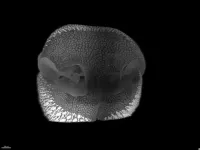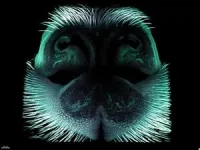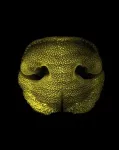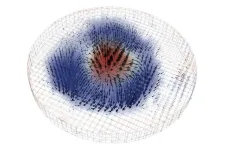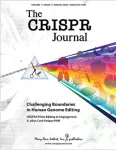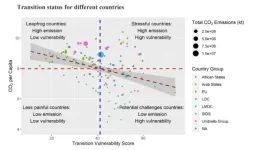(Press-News.org) The noses of many mammals, such as dogs, ferrets and cows, feature grooves forming a multitude of polygons. A team from the University of Geneva (UNIGE) has analyzed in detail how these patterns form in the embryo using 3D imaging techniques and computer simulations. The researchers discovered that differential growth of the skin tissue layers leads to the formation of domes, which are mechanically supported by the underlying blood vessels. This work describes for the first time this morphogenetic process, which could help explain the formation of other biological structures associated with blood vessels. These findings are published in the journal Current Biology.
The living world is full of remarkable shapes, some of which can be identified by their patterns of coloration or 3D motifs. Zebras and cheetahs, for example, can be recognized by their skin stripes or spots, while pine cones are characterized by their spiral organisation. These fascinating patterns are generated by various morphogenetic processes, i.e. the generation of shapes during embryonic development.
On the one hand, self-organisational morphogenesis can be mediated by chemical reactions, as described by Alan Turing’s reaction-diffusion model, where chemical substances diffuse and interact to create relatively regular patterns, such as the stripes or spots on the skin of mammals and reptiles. On the other hand, some shapes are the result of mechanical constraints. The human brain’s convolutions, for example, are produced by a process of differential growth: the cortex forms folds because it grows faster than the deeper layer to which it is attached.
The diversity of life
Michel Milinkovitch’s group, professor in the Department of Genetics and Evolution at the UNIGE Faculty of Science, investigates the evolution of the developmental mechanisms producing the complexity and diversity of life. ‘‘Finding specific examples of beautiful patterns in living organisms is easy. All we have to do is look around us! Our latest study focuses on the noses of dogs, ferrets and cows, which exhibit a singular network of polygonal structures,’’ explains Michel Milinkovitch.
Indeed, the naked skin of the rhinarium (nose) of many mammalian species features a network of polygons formed by grooves in the skin. By retaining moisture, these grooves keep the nose wet and, among other functions, facilitate the collection of pheromones and odorant molecules. The Geneva-based team collaborated with the Université Paris-Saclay, the École Nationale Vétérinaire d’Alfort (EnvA) and the Institute of Neurosciences de San Juan de Alicante for the collection of rhinarium samples from dog, cow and ferret embryos.
Nose 3D visualization
These samples were observed using ‘‘light sheet fluorescence microscopy”, a technique that enables the visualization of biological structures in three dimensions. In all three mammalian species, the researchers found that polygonal networks of folds in the epidermis - the outer layer of the skin - appear during embryogenesis, and are systematically and exactly superimposed over an underlying network of rigid blood vessels located in the dermis - the deeper layer of the skin. They also observed that epidermal cells proliferate faster than dermal cells.
Blood vessels form ‘‘architectural pillars’’
Using these data, the scientists developed a mathematical model and performed computer simulations of tissue growth. This model takes into account the difference in growth rates between the dermis and the epidermis, their respective stiffnesses and, most importantly, the presence of blood vessels in the dermis. ‘‘Our numerical simulations show that the mechanical stress generated by excessive epidermal growth is concentrated at the positions of the underlying vessels, which form rigid support points. The epidermal layers are then pushed outwards, forming domes - akin to arches rising against stiff pillars,’’ explains Paule Dagenais, post-doctoral fellow in the Department of Genetics and Evolution at UNIGE’s Faculty of Science, and first author of the study.
These results show that, in the case of rhinaria, the position of the polygonal structures of the epidermis is imposed by the position of the rigid blood vessels of the dermis, which exert local constraints during epidermal growth, leading to the formation of grooves and domes at precise locations. ‘‘This is the first time that this mechanism, which we call ‘mechanical positional information’, has been described to explain the formation of structures during embryonic development. But we are confident that it will help explain the formation of other biological structures associated to the presence of blood vessels,’’ concludes Michel Milinkovitch.
END
Geometric mechanics shape the dog's nose
A UNIGE team has discovered the physical properties that generate the grooves found on the noses of many mammals.
2024-10-22
ELSE PRESS RELEASES FROM THIS DATE:
‘Visual clutter’ alters information flow in the brain
2024-10-22
New Haven, Conn. — Whether we’re staring at our phones, the page of a book, or the person across the table, the objects of our focus never stand in isolation; there are always other objects or people in our field of vision. How that visual “clutter” affects visual processing in the brain, however, is not well understood.
In a new study published Oct. 22 in the journal Neuron, Yale researchers show that this clutter alters how information flows in the brain, as does the precise location of that clutter within the wider field of vision. The findings ...
Researchers succeed in taking 3D x-ray images of a skyrmion
2024-10-22
A difficult-to-describe nanoscale object called the magnetic skyrmion might one day yield new microelectronic devices that can do much more — for example, massive data storage — all while consuming much less power.
But researchers need a more detailed understanding of skyrmions if they are ever to be used reliably in computational devices, including quantum computers. Peter Fischer, a senior researcher at the Department of Energy’s Lawrence Berkeley National Laboratory (Berkeley ...
MRI can save rectal cancer patients from surgery, study suggests
2024-10-22
Magnetic resonance imaging (MRI) can spare many patients with rectal cancer from invasive surgery that can carry lifelong side effects, new research indicates.
The findings, from UVA Cancer Center’s Arun Krishnaraj, MD, MPH, and collaborators, indicate that MRI can predict patient outcomes and the risk of the tumor reccurring or spreading for patients who have undergone chemotherapy and radiation.
That information could be extremely useful in determining the best course of treatment and deciding whether a patient can ...
Fyodor Urnov on clinical crisis in CRISPR genome editing
2024-10-22
New Rochelle, NY, October 18, 2024—An invited Guest Editorial entitled “Give Cas a Chance,” by Fyodor Urnov, PhD, Director of Technology & Translation at the Innovative Genomics Institute (IGI), anchors the October 2024 special issue of The CRISPR Journal on “CRISPR Trials.”
As guest editor of the special issue, Dr. Urnov has penned an extraordinary editorial that emphatically defines the magnitude of the crisis in the genome editing arena and offers a path forward. The inherently programmable nature of CRISPR gene editing that makes it ...
People with type 2 diabetes who eat low-carb may be able to discontinue medication
2024-10-22
WASHINGTON—Adults with type 2 diabetes on a low-carbohydrate diet may see benefits to their beta-cell function allowing them to better manage their disease and possibly discontinue medication, according to new research published in the Endocrine Society’s Journal of Clinical Endocrinology & Metabolism.
Beta-cells are endocrine cells in the pancreas that produce and release insulin, the hormone that controls blood sugar levels.
More than 38 million Americans have diabetes, and over 90% of them have ...
Air pollution linked to having a peanut allergy during childhood
2024-10-22
Exposure to higher levels of air pollution as a baby is linked to having a peanut allergy throughout childhood, according to a new study. And policies aimed at tackling poor air quality could potentially reduce the prevalence and persistence of peanut allergies, it stated.
The research, led by Murdoch Children’s Research Institute (MCRI) and the University of Melbourne, found being exposed to higher levels of air pollution from infancy was associated with increased odds of developing a peanut allergy and having the allergy persist across the first 10 years of life. However, the same association was not seen for egg allergy or eczema.
Published ...
Dangers of the metaverse and VR for US youth revealed in new research
2024-10-22
The metaverse, a space where the lines between physical and digital realities blur, is rising among younger populations. As of March, 33% of teens own a virtual reality (VR) device and 13% use it weekly.
With the metaverse offering richer emotional experiences, youth may be particularly vulnerable to significant harm in these immersive spaces, underscoring the need to explore potential risks.
Unfortunately, research of online victimization in the metaverse is sorely lacking. A new study by Florida Atlantic University, in collaboration with the University of Wisconsin-Eau Claire, is one of the first to examine the ...
A national indicator for a just energy transition
2024-10-22
The Energy Transition Vulnerability Index (ETVI) quantifies the vulnerability of nations to adverse impacts of transitioning away from fossil fuels. The COP28 agreement has called for all countries to wind down use of fossil fuels to combat climate change—but the agreement stipulates that these transitions should not disproportionately harm historically marginalized and vulnerable stakeholders. Xunpeng Shi and colleagues create a method of quantifying energy transition vulnerability for 135 countries from 2010 to 2020. The indicator focuses on exposure—which captures the magnitude of the changes required—, ...
Cognitive effort whets the appetite for reward
2024-10-22
Mental fatigue may make rewards more desirable, according to a study in rats and humans. Exerting cognitive effort has been linked with making unhealthy choices. In the past, the link has been explained via a weaking of inhibitory control or will power. Marcello Solinas and colleagues explore the possibility that cognitive effort may also make unhealthy choices more tempting by increasing the perceived reward. Rats who completed a cognitively demanding task self-administered more cocaine than rats who did not complete a cognitive demanding task—or rats who were allowed ...
European funders and organizations partner to promote sustainable research
2024-10-22
A significant step forwards in changing research practices towards sustainability has been taken with the publication of the Heidelberg Agreement on Environmental Sustainability in Research Funding. The agreement provides a framework for research funders to play an active role and incentivize sustainable practices in research. It outlines principles for transitioning to a more sustainable research system and practical recommendations on how to implement sustainability in funding schemes.
A key focus of the Heidelberg Agreement is to ensure that research funders take a proactive approach to promoting sustainability in scientific ...
LAST 30 PRESS RELEASES:
Interaction of climate change and human activity and its impact on plant diversity in Qinghai-Tibet plateau
From addressing uncertainty to national strategy: an interpretation of Professor Lim Siong Guan’s views
Clinical trials on AI language model use in digestive healthcare
Scientists improve robotic visual–inertial trajectory localization accuracy using cross-modal interaction and selection techniques
Correlation between cancer cachexia and immune-related adverse events in HCC
Human adipose tissue: a new source for functional organoids
Metro lines double as freight highways during off-peak hours, Beijing study shows
Biomedical functions and applications of nanomaterials in tumor diagnosis and treatment: perspectives from ophthalmic oncology
3D imaging unveils how passivation improves perovskite solar cell performance
Enriching framework Al sites in 8-membered rings of Cu-SSZ-39 zeolite to enhance low-temperature ammonia selective catalytic reduction performance
AI-powered RNA drug development: a new frontier in therapeutics
Decoupling the HOR enhancement on PtRu: Dynamically matching interfacial water to reaction coordinates
Sulfur isn’t poisonous when it synergistically acts with phosphine in olefins hydroformylation
URI researchers uncover molecular mechanisms behind speciation in corals
Chitin based carbon aerogel offers a cleaner way to store thermal energy
Tracing hidden sources of nitrate pollution in rapidly changing rural urban landscapes
Viruses on plastic pollution may quietly accelerate the spread of antibiotic resistance
Three UH Rainbow Babies & Children’s faculty elected to prestigious American Pediatric Society
Tunnel resilience models unveiled to aid post-earthquake recovery
Satellite communication systems: the future of 5G/6G connectivity
Space computing power networks: a new frontier for satellite technologies
Experiments advance potential of protein that makes hydrogen sulfide as a therapeutic target for Alzheimer’s disease
Examining private equity’s role in fertility care
Current Molecular Pharmacology achieves a landmark: real-time CiteScore advances to 7.2
Skeletal muscle epigenetic clocks developed using postmortem tissue from an Asian population
Estimating unemployment rates with social media data
Climate policies can backfire by eroding “green” values, study finds
Too much screen time too soon? A*STAR study links infant screen exposure to brain changes and teen anxiety
Global psychiatry mourns Professor Dan Stein, visionary who transformed mental health science across Africa and beyond
KIST develops eco-friendly palladium recovery technology to safeguard resource security
[Press-News.org] Geometric mechanics shape the dog's noseA UNIGE team has discovered the physical properties that generate the grooves found on the noses of many mammals.
